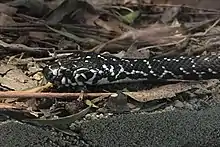Broad-headed snake
The broad-headed snake (Hoplocephalus bungaroides) is a venomous snake that is restricted to the Sydney Basin in NSW, Australia. It is one of 3 snakes in the genus Hoplocephalus, all restricted to eastern Australia. It is currently endangered in New South Wales and is listed as Vulnerable under the Commonwealth Legislation.
| Broad-headed snake | |
|---|---|
 | |
| Scientific classification | |
| Kingdom: | Animalia |
| Phylum: | Chordata |
| Class: | Reptilia |
| Order: | Squamata |
| Suborder: | Serpentes |
| Family: | Elapidae |
| Genus: | Hoplocephalus |
| Species: | H. bungaroides |
| Binomial name | |
| Hoplocephalus bungaroides (Schlegel, 1837) | |
Description

The broad-headed snake is a small to medium-sized species of venomous snake. Fully-grown snakes attain an average maximum length of 60 cm although some records show that they can grow as large as 90 cm. They are black with numerous irregular yellow markings arranged in narrow cross-bands, which for inexperienced people can easily lead to confusion with young Diamond Pythons which are superficially very similar and found in the same habitat.
Habitat
The broad-headed snake is found in the Sydney Basin in New South Wales, Australia. The snake's choice of habitat depends on temperature, age, gender, and breeding status. In the colder months, adult and juvenile snakes reside in the crevices of sandstone outcrops on exposed cliff edges to maximise warmth from the sun. When the temperature rises in spring, adult males and non-breeding females move to adjacent woodlands and forests, inhabiting hollow trees during the summer months. Juvenile snakes and gravid females remain in the rocks and move to cooler, shaded areas.
Their habitat has been degraded by urbanization, illegal rock removal, vandalisation and indiscriminate reptile collecting. The sandstone rocks that the snakes occupy are valued for landscaping purposes. Their removal has led to a loss of habitat for both the snakes and their prey.
Behavior
Diet
Broad-headed snakes feed infrequently on small reptiles and mammals. Snakes in captivity are able to maintain or gain weight when fed one to two newborn rats per month. In one documented case, a snake survived a fast lasting twelve months.
Juvenile snakes feed mostly on Lesueur's velvet geckos (Amalosia lesueurii) and occasionally on small skinks. Adult snakes feed on Lesueur's velvet geckos, but also prey on lizards, small-eyed snakes, and mice.
Breeding
Male snakes reach maturity after five years whereas females require six. Mating occurs from autumn to spring and mature females produce a litter every two years. Unlike most of its venomous counterparts, the broad-headed snake gives birth to live young. Birth occurs between January and April, with each litter resulting in 4–12 offspring born in mucous sacks. Unfertilized oocytes and stillborn offspring are common.
Status
The broad-headed snake was once commonly found in parts of Sydney including around Sydney Harbour; however, it is currently listed as an endangered species in New South Wales and vulnerable under the national Commonwealth Legislation. Its declining numbers are the result of a combination of factors including habitat loss through urbanisation, bush rock removal and irresponsible collecting
